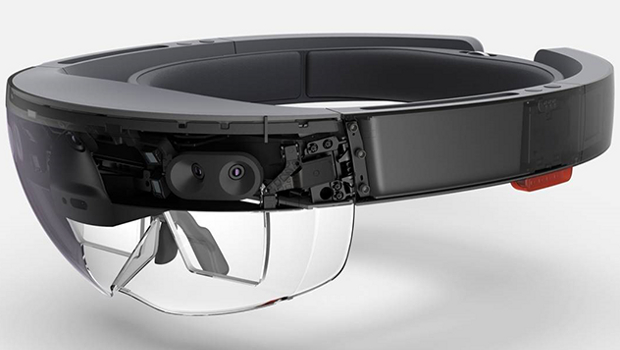Even though an early iteration of Microsoft’s HoloLens augmented reality headset is already shipping to enthusiasts, one of its key details has remained shrouded in mystery: What’s inside that funky ‘holographic processing unit’ that works alongside the device’s CPU and GPU, anyway? During the annual Hot Chips conference in Cupertino, California, Microsoft pulled back the curtain on its secretive chip.
The HoloLens’ HPU is a custom 28nm coprocessor designed by TSMC, The Register reports. The chip packs 24 Tensilica digital signal processor (DSP) cores. As opposed to more general purpose CPU cores, DSPs are a specialized technology designed for rapidly processing data flowing in from the world – a no doubt invaluable asset while rendering augmented reality environments in real time. Microsoft’s HPU also contains roughly 65 million logic gates, 8Mb of SDRAM, and 1Gb of traditional DDR3 RAM. It draws less than 10W of power, and features PCIe and standard serial interfaces.
The speeds and feeds of the exotic holographic processing unit matter only to geeks. The important part is what all those those logic gates and DSP cores enable the HoloLens to do.
Meet the HoloLens HPU
The HPU is designed to handle all the information streaming in from the array of cameras and sensors on the HoloLens. This data is essential for any VR-style headset, but especially so in an augmented reality device that overlays digital images on the real world.
The HPU’s dedicated hardware is up to 200 times faster than performing the same calculations via software on the less-specialized 14nm Intel Cherry Trail CPU. Microsoft added custom instructions to the DSP cores that allow the HPU to churn through HoloLens-specific tasks even faster, The Register reports. The HPU can perform roughly 1 trillion calculations per second, and the data it passes to the CPU requires little additional processing.
The HPU’s gruntwork leaves the HoloLens’ GPU and CPU free to concentrate on running Windows 10 and any additional apps, rather than spending their time parsing complex environmental data. That’s particularly important because unlike the Oculus Rift or HTC Vive, the HoloLens is a self-contained, standalone device, completely reliant on its onboard hardware.
IDG News Service







Subscribers 0
Fans 0
Followers 0
Followers